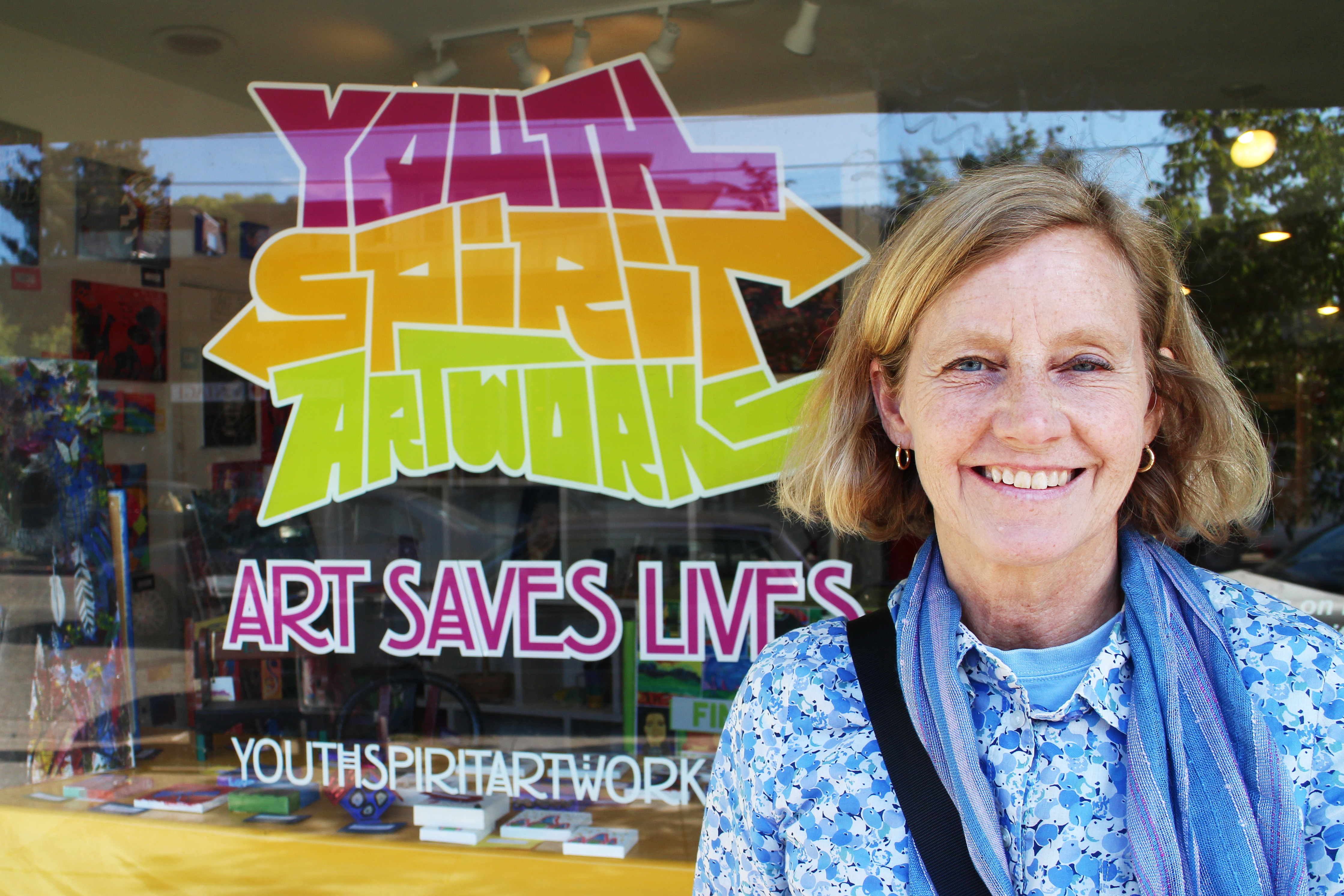The neighborhood of South Berkeley, just under two miles from downtown and the University of California at Berkeley campus, is the poorest region of the city — home to nearly 500 homeless youth and hundreds of other near-homeless young adults living below the poverty level.
Even so, a vibrant Alcatraz Avenue storefront in this neighborhood, decked out in colorful paintings, offers a paid opportunity for these youths to express their creativity and grow professionally. Since its inception, Youth Spirit Artworks (YSA) has served hundreds of local young people ages 16 through 25, with 144 in the studio’s free programs during 2014. Ninety percent are young people of color, and approximately 40 percent are homeless.
Jay Hill, 22, an aspiring fashion designer who lives with his single mother, didn’t have access to spaces or resources like YSA while growing up. After he graduated from Franklin High School in Elk Grove, Calif., Hill, now 22, did not go on to postsecondary education. Moving to South Berkeley at age 20 and working a retail job, Hill said he did not feel like he was working toward his full potential.
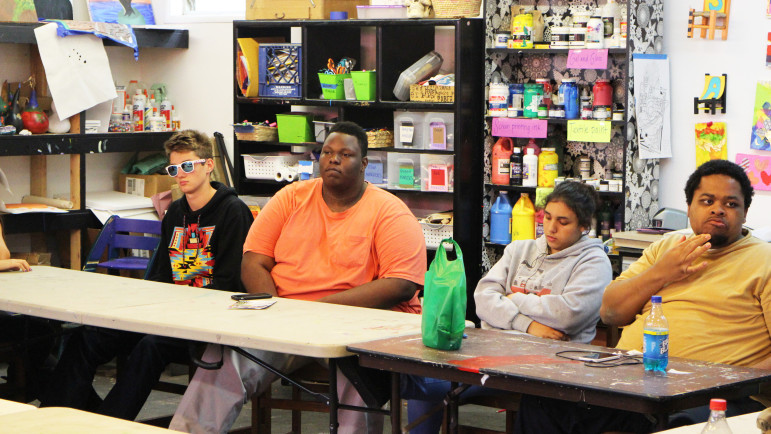
Sarah Zahedi
Jay Hill (second from left) sits alongside fellow artists at a YSA meeting.
“I graduated high school, and I didn’t have bad grades or anything, but afterward, nothing happened,” Hill said. “It was like, ‘Oh my god, I see all my friends doing stuff and I’m the only one just sitting here, living with my mom.’”
A friend told him about Youth Spirit Artworks, and he decided to check it out nine months ago.
“At first, I was skeptical because I thought I might not like it … already having the negative outlook since I hadn’t been doing nothing for almost three years [after graduating high school],” Hill said. “I was really intimidated at first because I’m not a painter, I’m a fashion illustrator, so I thought I wasn’t going to fit in.”
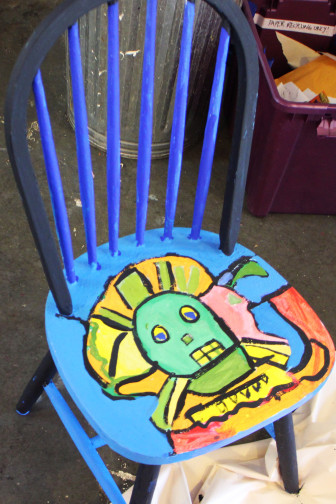
Sarah Zahedi
A painted chair inside the YSA studio.
As soon as he stepped into the studio, Hill’s outlook changed. Coming to YSA every weekday for six hours per day, he has participated in the studio’s fine art and community art program, creating original artwork made from recycled and reused materials and collaborating with community partners to help local businesses better their neighborhoods with murals and mosaic art signs.
Along the way, Hill has learned about earning money, spending wisely through budgeting, saving and investing, using credit cautiously and protecting one’s personal finances through YSA’s accredited job-training workshop curriculum.
“It has been a fun experience and has pushed me out of my comfort zone,” Hill said. “I feel more able to get a job where I can be interactive and talk to people, not just a job where you’re like, ‘Ring this up for me.’”
When Executive Director Sally Hindman founded YSA in 2007, she envisioned a place where homeless and near-homeless youth could come to create and sell art, learn job skills and contribute to their neighborhoods through community revitalization art projects. Working for more than 20 years in nonprofit management, primarily with homeless people, Hindman said she became aware of the need for a space for local homeless youth — a space that would give them opportunities to use art to unleash their creative energy and to experience a supportive peer community.
[Related: Music & Arts Therapists Help Youth Find Their Voice, Break Free from Addiction]
“For youth who are more affluent, their parents are sending them to lovely camps, and they’re having special opportunities to learn how great they are and learn what they are good at through these experiences,” Hindman said. “But for the low-income and homeless youth, it’s nothing like that. So we try to work with these youth to define what they love and where their skills are so they can have these opportunities, too.”
With a $20,000 grant from the city of Berkeley, Hindman started YSA with a group of equally dedicated community members and the support of Berkeley City Council Member Max Anderson.
Hindman said many of the job-training participants are able to move toward a more stable lifestyle, even as young people face high rates of unemployment. Nationwide, unemployment among people ages 16 to 24 is 12.4 percent.
Teens at YSA receive a small stipend for their work hours, ranging from $125 to $370 per month, depending on the individual’s time commitment. In addition, they can earn money from selling their art, which are priced at $25 to $160, depending on size. The artists receive half the sale income. The other half, about $7,000 in revenue last year, supports the program. YSA’s $267,000 annual budget last year also included revenue from the City of Berkeley, private donors, corporations and foundations, and commissions.
“With many of these youth, there’s unemployment in the family, incarceration or other things that get in the way of stable work, so they oftentimes don’t really have experience of working, being on time, dressing professionally and developing a working habit or pattern,” Hindman said. “They are learning that you can work hard and get stuff you need and stuff you want, and do fun things in life that they didn’t think they could have.”
 Find articles, research and resources on Program Quality at the Youth Today Out-of-School Time Research and Resource Hub.
Find articles, research and resources on Program Quality at the Youth Today Out-of-School Time Research and Resource Hub.
Youth Spirit Artworks’ staff helped place eight participants into full-time jobs last year — 100 percent of those who requested help. The staff also advises participants about pursuing higher education or finding housing. Hindman said YSA’s programs are youth-led so participants develop the confidence they need to succeed in future endeavors and professions.
“Increased self-confidence and feelings of self-worth are huge areas of success that we have seen in the program,” Hindman said. “There’s feelings of empowerment and a sense of belonging and community.”
Hill said this sense of community helped him come into his own. From an early age, he knew he was gay. However, he said his family taught him that being gay was wrong. Kids at school never helped him feel accepted either, he said.
“Growing up, you had to be ghetto to fit in, and I wasn’t a ghetto kid … I wasn’t into gangbangs … I was into ‘Sailor Moon’ so I was beyond a different world from the kids,” Hill said. “I couldn’t be myself around my family and had to hide who I am.”
The supportive community of friends and mentors at YSA has made all the difference, Hill said.
“People actually listen to me here, and at home, no one listened to me,” Hill said. “If I had issues, they would say ‘Get over it,’ and here they make you talk about your feelings and to be honest with yourself. A lot of skeletons have left my closet since I’ve been here ’cause I had so much bottled in.”
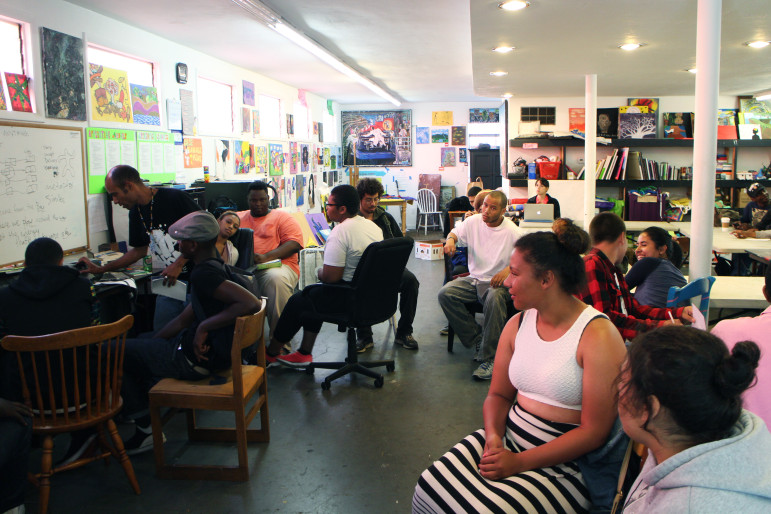
Sarah Zahedi
Youth during a jobs training session inside YSA.
YSA Art Director Victor Mavedzenge said creating art is a comfortable way for young people to heal and grow from their experiences.
“We need to understand where they’re coming from and what inhibits them from progressing to the next step,” Mavedzenge said. “Art is beyond a shadow of a doubt therapeutic and healing because for a moment you step away from anything you’re going through. It’s a chance to breathe, a chance to reset your system and bring a new reality to an otherwise blank page.”
The concept of creating art as a means of therapy and healing is not uncommon. The International Society for Traumatic Stress Studies has found a relationship between creative arts therapies and the brain, including how the brain processes traumatic events and the possibilities for reparation through art.
The American Art Therapy Association emphasizes that art therapy programs help kids build resilience and move beyond life’s hurdles, promote self-awareness, improve self-esteem and competence, develop coping and control skills, and lead to a stronger future.
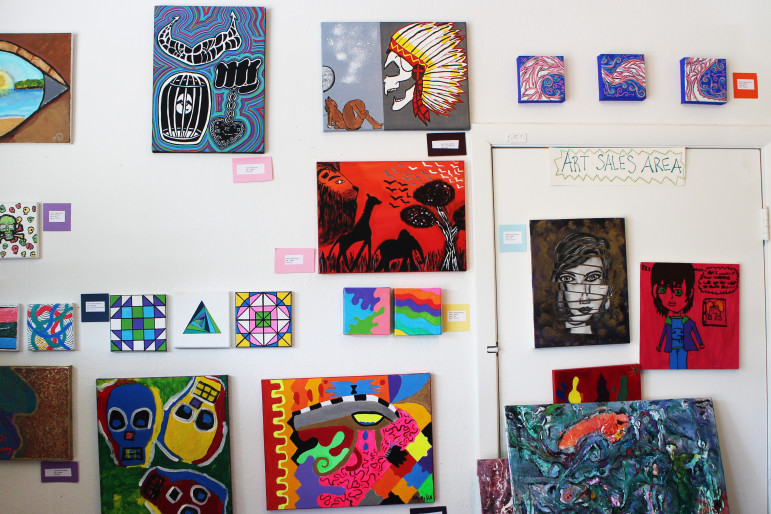
Sarah Zahedi
Artists at YSA display their pieces at the front of the YSA studio.
Homeless and near-homeless youth are at great risk of suffering these traumatic life hurdles. The National Law Center on Homelessness and Poverty documents that 43 percent of homeless youth were beaten by a foster parent or caretaker, 25 percent were sexually propositioned by a caretaker, and 20 percent left home over conflict with their parents about their LBGTQ status.
“Art is really a vehicle for healing and transformation and getting to know youth, cutting through layers of trauma they’ve experienced, learning to express their feelings and understand themselves,” Hindman said. “Our motto is ‘Art Saves Lives’ because we use art and the job training that comes with it to take steps to make these youths’ lives wonderful, meet their goals and become who they want to be.”
Although Hill said he does not consider himself an “emotional” artist, he finds his art to be an outlet to showcase his personality.
“When you see my stuff, it’s very bright and colorful because that’s who I am,” Hill said. “I’m positive and vibrant. People really like my artwork, so I am glad I didn’t just back out of the experience.”
Hill has risen through the studio’s different progression levels, which determine a participant’s job readiness and success in the programs. When young people first come into the studio, they work as art aspirants, learning soft job skills to succeed in the workplace. After one semester as aspirants, they can apply to become apprentices, then apprentice leaders, developing hard job skills like art entrepreneurship and sales, social work, nonprofit management or communication, and social media marketing. Finally, fellow artists at YSA can vote for their peers to become junior artists, like Hill. They are considered job-ready and thus take on more responsibility in business training, helping with other participants’ art sales, in nonprofit social work training, working as a peer mentor or in studio art training. When Hill was elected as a junior artist, he said he was excited to find a space he could call home.
“Being home after high school, I really didn’t have friends to hang out with,” Hill said. “Here, it’s like ‘Oh my god,’ it’s so perfect. I have friends. I’m more comfortable here than at my home. Eventually, I’ll have to leave here and spread my wings, but I’m not leaving anytime soon.”
With the help of his community at YSA, Hill said he is motivated to achieve his main goal of becoming a fashion designer.
“It’s good to know that with a place like this around, there’s a place that will actually care about you and hear your stories,” Hill said. “There’s always hope, there’s always a dream, you just got to go for it.”
More stories on related topics:
The Corps Network Helps Court-involved Youth Nurture New Skills
Newark Program Prepares Low-Income Teens for College, Workforce
‘Our Kids’ — How One San Francisco Program Gets Teens Off Drugs


